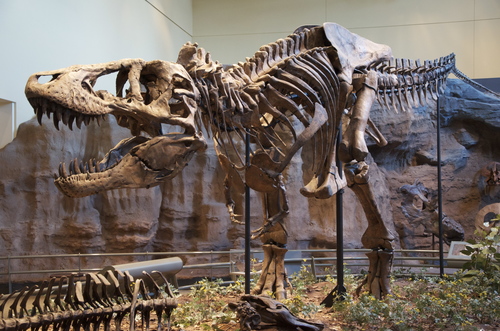
Tyrannosaurus
The iconic Tyrannosaurus rex, with its towering stature and formidable bite, dominated late Cretaceous ecosystems. This apex predator's keen senses and powerful build made it a master hunter, shaping its prehistoric environment and capturing imaginations as one of history's most infamous dinosaurs.
9000.0 kg
Weight
Length: 12.192 m; Height: 3.6576 - 3.9624 m
Size
Characteristics
The Tyrannosaurus rex, a colossal theropod dinosaur, lived during the Late Cretaceous period. It was a carnivorous apex predator, known for its massive skull, powerful jaws with serrated teeth, and bipedal stance. T. rex roamed plains and forests, using its keen sense of smell to hunt.
Distribution Range of the Tyrannosaurus
The Tyrannosaurus rex was native to what is now North America. Fossil evidence indicates that its distribution primarily spanned the western United States, including states such as Montana, South Dakota, and Wyoming, as well as parts of Canada, particularly in the provinces of Alberta and Saskatchewan.
Tyrannosaurus's Habitat
Environmental Conditions
During the late Cretaceous period, approximately 68 to 66 million years ago, the environmental conditions of the area inhabited by Tyrannosaurus rex were characterized by a warm, semi-tropical climate. This period experienced significant seasonal variations in temperature and precipitation, conducive to diverse ecosystems.
Ecological Niche
Tyrannosaurus rex occupied the ecological niche of a top predator. It inhabited floodplains, coastal plains, and forested environments rich in flora and fauna, which provided ample hunting opportunities. Its role as an apex predator allowed it to target large herbivorous dinosaurs and potentially scavenge as well. The presence of diverse plant life including cycads, ferns, and conifers supported a rich ecosystem, pivotal for sustaining large terrestrial vertebrates.
Copyright @ Nature Style Limited. All Rights Reserved.
 English
English